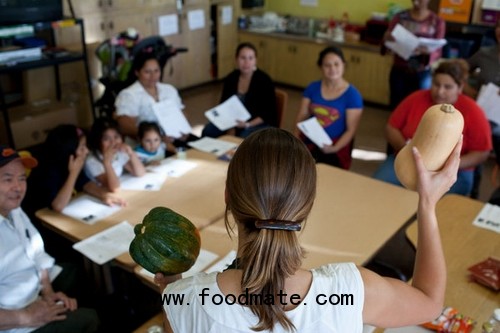
For the recent East Coast hurricane, as in other emergencies, food banks were on the front lines with food, bottled water and cleaning supplies. They have long held sway in the public consciousness as providers of nonperishables.
But in fact, holding food drives and handing out cans of soup and tuna make up only a small part of what food banks do over the course of a year. Count the timely provision of fresh produce and nutrition education as among their newer core duties.
For millions of people, food banks have become more than a stopgap measure; rather, they are a chronic coping strategy, said Maura Daly, chief communication and development officer at Feeding America, the umbrella organization for the nation’s 200-plus food banks. “The majority of our clients are receiving food assistance for six months or longer,” she said.
Food banks provide assistance to more than 37 million Americans a year through more than 61,000 outlets, including food pantries, soup kitchens and emergency shelters, Feeding America said. The number of people served by food banks rose 46 percent from 2006 to 2010, mainly because of the recession, which Ms. Daly said increased demand among the unemployed and also among the working poor and the underemployed.
The storm’s impact has strained the organization as it balances emergency relief with its role of serving clients’ long-term needs, Ms. Daly said. An added challenge is the storm’s timing: just before the holiday season, which is the busiest period of the year for food banks.
But when such emergencies are not absorbing their attention, food banks have increasingly moved beyond providing short-term supplies of food and water to confronting chronic hunger and poor nutrition, and the reality that the poor can suffer from hunger and obesity.
More efforts are in place to feed children during nonschool hours, to reach low-income seniors and to bring mobile pantries to neighborhoods that lack nearby food sources. Food banks are also encouraging more people to take advantage of the federal food stamp program, now known as the Supplemental Nutrition Assistance Program, which was greatly expanded since the recession.
Just as groceries and restaurants have turned their attention to fresh produce in recent years, so have food banks; this has meant a greater focus on nutrition education and new logistical challenges of delivery. “Two-thirds of the food we distribute is fresh produce,” said Paul Ash, executive director of the San Francisco and Marin Food Banks. Much of the food comes from packers and growers, he said, and if a truckload of carrots comes in, the food bank has no time to dither about what to do with it.
Since “we have some clients who don’t have a good grasp of the basics of nutrition,” as Mr. Ash puts it, the San Francisco organization also offers cooking classes, while recognizing that many of its clients have limited kitchens. In a recent class, for example, students learned how to prepare ratatouille and scrambled eggs in a microwave.
The organization also sets up food pantries that resemble farmers markets. “It’s a really respectful experience,” Mr. Ash said, and clients can choose among a variety of foods.
Some food banks are buying farmland as a way to bring more fresh produce to their clients. Several years ago, for example, the Vermont Foodbank bought a farm in Warren, Vt.; it is farmed by a couple who make their lease payments in food. Volunteers from local food organizations come to the farm to gather their share.
Refrigeration is also crucial to adding more produce to the diets of food bank clients. Hundreds of refrigerated trucks go to retail locations like Walmart, Kroger and Target and pick up food that is “fully consumable but nearing its ‘best if used by’ date” for use by food banks, Ms. Daly of Feeding America said.
A food bank in Tennessee in 2005 received enough charitable funding to invest in manufacturing technology that can cook and then freeze fresh food for use up to a year later. A culinary team comes up with meal ideas based on the donations that arrive. The ingredients are pressure-cooked and placed in bags, which are then flash-frozen to lock in taste and nutrition, said Tasha Kennard, vice president of marketing and communications for the Second Harvest Food Bank of Middle Tennessee, which includes the Nashville area.
Meals like spaghetti, chicken and dumplings, burritos and chili can be fully cooked and frozen this way, to be reheated by clients later. Only a handful of food banks have this kind of equipment, so the Nashville plant also makes frozen meals for other food banks across the country.
With all of these innovations occurring at food banks, is there still a place for the humble food drive? “Food drives are a wonderful way for people to engage with the issue of hunger,” Ms. Daly said, but they account for only a tiny percentage of food banks’ supplies. Food donations come mainly from corporations, the government and growers.
Andy Fisher, a co-founder of an antihunger organization, maintains that Feeding America’s dependence on corporations for donations is preventing it from doing the type of advocacy work, in areas like the minimum wage and health care, that could help eliminate some of the root causes of hunger and poverty. Emergencies like hurricanes are exactly the kinds of things that food banks should mainly handle, he said. “They do a great job of that; they’re incredibly well prepared logistically.”
Ms. Daly said Feeding America wanted to remain a bipartisan organization, and took positions only on policies that directly affected its food banks and clients. Because of limited resources, she said, the group focuses solely on its core mission of feeding the hungry





